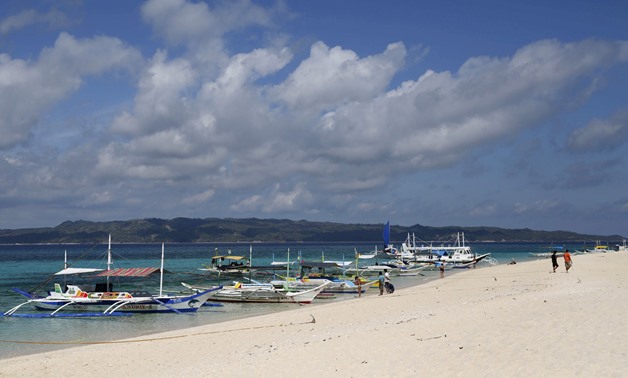
Traditional boats line up the shore in a secluded beach on the island of Boracay, central Philippines January 18, 2016. REUTERS/Charlie Saceda/File Photo
MANILA - 06 April 2018: The Philippines will tear down illegal structures, build a bypass to unclog traffic, convert tricycle taxis into electric vehicles and build a modern waste-to-energy plant to rescue its premier tourist island, the government said on Friday.
Authorities have yet to provide much detail beyond that for the planned rehabilitation of Boracay island, which President Rodrigo Duterte recently described as a "cesspool" and ordered closed for six months.
The government says the overhaul is necessary to save the tiny island, which generated over $1 billion last year but cannot cope under the strain of 2 million tourists a year.
Boracay will be closed to tourists from April 26 to pave the way for a cleanup. No budget has been announced for the work.
Some 195 businesses in Boracay were found to be discharging untreated waste water into the sea, resulting in increased concentration of human faeces along the beaches and posing health risks to swimmers.
Duterte ordered the shutdown on Wednesday, and businesses are scrambling to prepare as airlines slash flights to Boracay and try to channel visitors to other holiday islands in the archipelago nation.
The closure reflects the growing pressures on beach resorts across Southeast Asia as visitor numbers surge.
The rehabilitation period for Boracay, however, may go beyond six months, and the cost of making it liveable again had yet to be determined, Environment Undersecretary Jonas Leones told a media briefing.
Authorities have yet to finalise the waste-to-energy plant's capacity which, Leones said, offered a long-term solution to the garbage problem of an island that produces 90 to 115 tonnes of trash a day.
Environment Secretary Roy Cimatu said about 1,000 three-wheel taxis and cars in Boracay could be converted into electric vehicles, but details had to be discussed with the energy department.
The environment ministry has issued a "notice of violation" to businesses discharging sewage and has ordered the destruction of more than 900 illegal structures in forest and wetlands.
"The wetlands will be rehabilitated. The forest lands will be recovered and properly taken care of," Cimatu said, appealing for understanding from residents and businessmen.
"This is a short-term sacrifice, this is for their own good," he told reporters.
On the northern tip of the central Panay island, Boracay is home to more than 30,000 people whose livelihoods depend on tourism, directly and indirectly.
One of 7,300 Philippine islands, it hosts 1,800 businesses, including global hotel chains like Shangri-La and Movenpick, and locally listed companies Megaworld Corp and Manila Water Co Inc.
The government's 2 billion pesos ($38.4 million) for a "calamity fund" to help people in Boracay may not be enough to tide residents over for six months, said Jose Clemente, president of the Tourism Congress of the Philippines.
"Something pervasive in the island now is everyone does not know what's going to happen to them. So much uncertainties." he said in an interview with CNN Philippines.


Comments
Leave a Comment